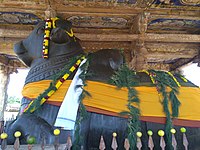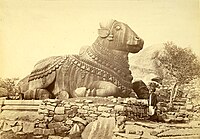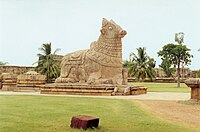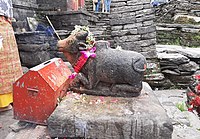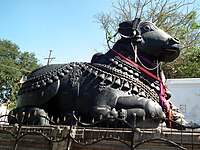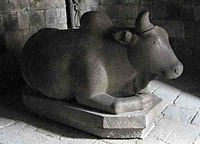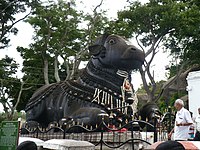Nandi (Hinduism)
| Nandi | |
|---|---|
 Nandi in a zoo-anthropomorphicform | |
| Affiliation | Mount ofShiva |
| Abode | Mount Kailash |
| Consort | Suyasha[1] |
| Part ofa serieson |
| Shaivism |
|---|
 |
|
|
Nandi(Sanskrit:नन्दि), also known asNandikeshvaraorNandideva,is the bullvahana(mount) of theHindu godShiva.He is also theguardiandeity ofKailash,the abode of Shiva. Almost all Shiva temples display stone images of a seated Nandi, generally facing the main shrine.
Etymology[edit]
The Sanskrit wordnandi(Sanskrit:नन्दि) means happy, joy, and satisfaction, the properties of divine guardian of Shiva-Nandi.[2]
The application of the name Nandi to the bull (Sanskrit:Vṛṣabha) is a development of recentsyncretismof different regional beliefs within Shaivism.[3]The name Nandi was widely used instead for an anthropomorphicdoor-keeperof Kailash, rather than his mount in the oldest Shaivite texts in Sanskrit, Tamil, and other Indian languages.Siddhantatexts distinguish between Nandi andVṛṣabha.[4]
Legend[edit]
Nandi is described as the son of the sage Shilada. Shilada underwent severe penance to have a boon– a child with immortality and blessings of Shiva, and received Nandi as his son.Shiva Puranasays that Nandi was born from ayajnaperformed by Shilada.[5]Nandi grew up as an ardent devotee of Shiva and he performed severe penance to become his gate-keeper, as well as his mount, on the banks of riverNarmada.According toregional legend,this site is identified with the Tripur Tirth Kshetra in present-day Nandikeshwar Temple, inJabalpur,Madhya Pradesh.
According toShaivaSiddhanta,Nandi is considered to be chief among theSiddhars,initiated byParvatiandShiva.He is regarded to have passed on what he had learned to his eight disciples, namely, theFour Kumaras,Tirumular,Vyagrapada(also known as Pullipani),[6]Patanjali,and Sivayoga Muni. They were sent out in eight different directions to spread his wisdom. His teachings are held by theNandinatha Sampradaya,a line ofguruswho claim descent from Nandi.[7][8]
ManyPuraniclegends are available about Nandi. One describes his conflict withRavana,the antagonist of theRamayana.Nandi cursed Ravana, therakshasaking ofLanka,that his kingdom would be burnt by a forest-dweller monkey (vanara), since he behaved in a restless manner, just like a monkey, while waiting to meetShiva.Later,Hanumanburned Lanka when he went in search ofSita,who was imprisoned by Ravana in the grove called theAshoka Vatika.[9]
The ancient Tamil textTiruvilaiyadal Puranammentions another story in which Nandi is incarnated as a whale.[10]According to this legend, Parvati lost her concentration while Shiva was explaining the meaning of theVedasto her. Parvati, then incarnated as a fisher-woman to atone for her lack of concentration. To unite his master and his beloved-wife, Nandi took the form of a whale and started to trouble the people. Parvati's father declared that the man who would kill the whale would marry his daughter. Later, Shiva took the form of a fisherman and killed the whale, and received Parvati in her previous form.[11]
TheCham Hindus of Vietnambelieve that when they die,Nanditakes their soul to the holy land of India from Vietnam.
Iconography[edit]
TheAgamasdescribe Nandi in a zoo-anthropomorphic form, with the head of bull and four hands, withantelope,axe, mace, andabhayamudra.In his mount form, Nandi is depicted as a seated bull in all Shiva temples, all over the world. This form has been found even inSoutheast Asiancountries includingCambodia.[12]
The white color of the bull symbolizes purity and justice. Symbolically, the seated Nandi faces the sanctum in Shiva temples and represents an individualjiva(soul) and the message that the jiva should always be focused on theParameshvara.From the yogic perspective, Nandi is the mind dedicated to Shiva, the absolute. In other words, to understand and absorb light, the experience, and the wisdom is Nandi, who is the guru within.[13]
Nandi Flag[edit]

Nandi flag or Vrshabha flag, a flag with the emblem of seated bull is recognized as the flag of Shaivism, particularly among Tamil community all over the world. Nandi was the emblem of historical Tamil Shaiva monarchs, such asPallava dynastyandJaffna Kingdom.[16]Several campaigns to aware the Shaivas about their Nandi flag is carried out continuously during theShivaratrisession, particularly amongTamil communityofSri Lanka,Tamil Nadu,anddiaspora.[17]
The Nandi flag used nowadays was designed by Ravindra Sastri ofMadurai,Tamil Nadu,according to the request and guidance of S. Danapala, aSri LankanShaiva personage, in the 1990s. The first Nandi flag was hoisted in 1998, atColombo Hindu CollegeatRatmalana,Sri Lanka.[18][19]Following years, it was declared as the official Shaiva flag in fourth International Saiva Siddhanta Conference, held in Zurich in 2008.[15]Nowadays, Tamil Shaivas, especially inSri Lanka,Canada,Australia,UK,South Africa,andSwitzerland,hoist the flag in all religious and cultural festivals.[15][18][19]Nandi flag was declared as the official Hindu flag of Sri Lanka.[20][21]
Gallery[edit]
-
Decorated Nandhi at temple inThanjavur
-
2nd-century CE sculpture of a Nandi inMysore
-
Nandi atGangaikonda Cholapuram
-
Nandi atTungnathMandir
-
Nandi atMysore
-
Nandi atPrambanan,Java, Indonesia
-
decorated
See also[edit]
- Kamadhenu
- Cattle in religion
- Gavaevodata,the primordial cow inZoroastrianism
- Kao (bull)
References[edit]
- ^Gopinatha Rao, T. A. (1997).Elements of Hindu Iconography, Volume 2.Motilal Banarsidass Publishers. p. 213.ISBN9788120808775.
- ^"Monier Williams' Sanskrit-English Dictionary".Retrieved5 March2017.
- ^Gouriswar Bhattacharya, (1977),"Nandin and Vṛṣabha",Zeitschrift der Deutschen Morgenländischen Gesellschaft,Supplement III,2, XIX. Deutscher Orientalistentag, pp. 1543–1567.
- ^Sabaratnam Sivacharyar, S.P.Shrimat Kamigagamah Purva Pada (Part One).USA: The Himalayan Academy, Kauai Adheenam. pp. 4:471–500.
- ^The Sacred Scriptures of India.Anmol Publications. 2009. pp. 77–79.ISBN978-81-261-3630-8.
- ^"IN THE LAND OF THE SIDDHAS".www.sutrajournal.com.Retrieved14 April2023.
- ^The Swamis of Kauai Hindu Monastery (2011).The Guru Chronicles: Making of the First American Satguru.Himalayan Academy Publications.p. 19.ISBN978-1-934145-40-1.
- ^Satguru Sivaya Subramuniyaswami (2003).Dancing with Siva: Hinduism's Contemporary Catechism.Himalayan Academy Publications.ISBN978-0-945497-89-9.
- ^Jayantika Kala (1988).Epic Scenes in Indian Plastic Art.Abhinav Publications. p. 37.ISBN9788170172284.
- ^Indian Association for English Studies (1995).The Indian Journal of English Studies, Volume 34.Orient Longmans. p. 92.
- ^The Indian Journal of English Studies.Orient Longmans. 1995. p. 92.
- ^"Shiva and Uma on the Bull Nandi".The Walters Art Museum.
- ^Vanamali (2013).Shiva: Stories and Teachings from the Shiva Mahapurana.ISBN978-1-62055-249-0.
- ^DBS.Jeyaraj (2013).Reviving Practice of Hoisting 'Nandi' (Crouched Bull) Flag As Hindu Festivals and Functions.
- ^abcKalabooshanam Chelvathamby Manickavasagar (2008)."Fourth International Saiva Siddhantha Conference and the Glory of Nanthy Flag".The Island.Retrieved5 March2017.
- ^Rasanayagam, Mudaliyar (1926). Ancient Jaffna, being research into the History of Jaffna from very early times to the Portuguese Period. Everymans Publishers Ltd, Madras (Reprint by New Delhi, AES in 2003). பக். 390.ISBN81-206-0210-2.
- ^"Hiduism Today, (2008), Hindu Campaigns for Restoration of Nandi Flag Tradition".Retrieved5 March2017.
- ^abTaṉapālā, kalāniti., Ciṉṉatturai., (2013), "Nantikkoṭi ēṟṟīr! Koṭikkavi pāṭīr!", Omlanka Publication.
- ^abCiṉṉatturai taṉapālā, (2008), "nantikkoṭiyiṉ mukkiyattuvamum perumaikaḷum", Manimekalai Publication.
- ^"Nanthi Flag to Maithripala Sirisena".Retrieved5 March2017.
- ^"Minister Swaminathan urged to Provide Nanthi Flags to Temples, Societies".Retrieved5 March2017.
External links[edit]
- Dictionary of Hindu Lore and Legend2004 (ISBN0-500-51088-1) by Anna Dallapiccola


